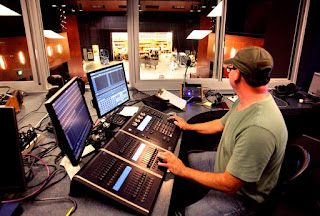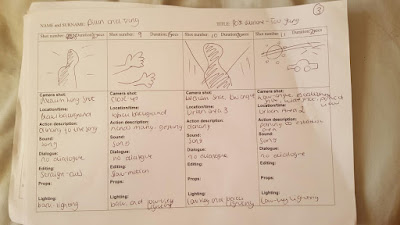Genre Ideas:
The genre of our song is Hip-pop which is a very popular genre that has particular conventions that
should be followed in order to have a successful music video with our target audience. We also decided to go against some of the traditional conventions of mainstream music videos which often attracts attention and creates huge hype. Our artist, conventionally will follow the original style of performing as does the genuine artist of 'Too Young' - Post Malone. This is evident is most hip-pop genres where the artist tends to perform his or hers song the way our original artist does. As our target audience will be hip-pop audiences ranging from ages of 16-28 are already familiar with how their favourite music videos are like, its best to follow this traditional convention to keep loyal fans happy.
Morals and Values:
As reflected form the lyrics, the song portrays the challenges and difficulties the young man has to go
through because of his social status of a young working class male. Because of this, the artist has to turn to illegitimate means to get through the day which isn't the safest of options, yet he has to go through with it thus the tittle of the song is 'Too Young' referring to the youths that are dying too young because of this. This is also reflected from the lyrics of the song when it says 'I don't want to die too young'. 'I've been grinding for too long' is also part of the chorus which means the artist had to go through a lot more than the average person to get his average pay. Because of the struggle he goes through, a young male with a working-class background, tuning to crime as a way out, he says 'counting bands, hallelujah' which means he is grateful for the money his got. He expresses this through the visuals of his music video from having flashy cars, expensive drinks and designer clothes.
Media Perception:
The original artist form the music video can be perceived as controversial by the media because of
the lyrics of his song, evoking drugs and other illegal things. His artist image can also be perceived by the media as controversial too because he is in fact a white male with cornrows. Although he does come from a working class background, our artist fits a more stereotypical working class male because he's black and is usually represented in the media. Although the song that we chose was quite mainstream, he also has a target audience of niche audiences rather than mainstream audiences because he mixes country and rap together.
Similar Artists:
 During our planning stage, other artists including 50 cent, Young Thug and Kanye West has influenced our original artist and so we decided to use them to help with our planning. Having similar music taste, Post Malone worked with the following artists which are mainstream artists in the hip-pop genre. In addition to helping us with our artist representation as the each portray their own unique style yet very similar using their own image in their music videos. Despite having each having a different artist image, they have similar morals and values as they all represent originality and sometimes may create controversy at times.
During our planning stage, other artists including 50 cent, Young Thug and Kanye West has influenced our original artist and so we decided to use them to help with our planning. Having similar music taste, Post Malone worked with the following artists which are mainstream artists in the hip-pop genre. In addition to helping us with our artist representation as the each portray their own unique style yet very similar using their own image in their music videos. Despite having each having a different artist image, they have similar morals and values as they all represent originality and sometimes may create controversy at times.
In our music video, using different urban shots where our artist will be at, we also want him to dress differently as it may reflect an existing character like these artists do in their own music video. We will make our artist dress in black hoodies and caps to reflect the youths nowadays and connote the dark side of being an individual coming from a working class background.
 Some of these artists are mainstream and others are niche but together have similar target audiences. I want my artist to be portrayed in a similar from the mainstream artists by following conventional music video conventions to attract that target audience. This will allow my music video to attract more audiences through social media, radio chat shows and public appearances.
Some of these artists are mainstream and others are niche but together have similar target audiences. I want my artist to be portrayed in a similar from the mainstream artists by following conventional music video conventions to attract that target audience. This will allow my music video to attract more audiences through social media, radio chat shows and public appearances. We are hoping to fulfil this type of artist image through mise en scene and cinematography. We believe if we are able to execute the right mise en scene and cinematography right for the shot then it will enhance the star image of our artist. Furthermore, this makes her more popular and interesting to watch on screen. By following theories we will also enhance this image.
We are hoping to fulfil this type of artist image through mise en scene and cinematography. We believe if we are able to execute the right mise en scene and cinematography right for the shot then it will enhance the star image of our artist. Furthermore, this makes her more popular and interesting to watch on screen. By following theories we will also enhance this image.Our Artist:
We have decided to use Emeka as our male artist as we believe he will be able to reflect the stereotypical aspects of the similar artists we have researched. He will be also allowed to express his own values and opinions through his persona and costume. We wanted to keep our music video similar to the original music video of our chosen artist so we're dressing him hoodies and trainers that our target audience are use to seeing. We also want him to dress in dark clothing to connote the dark side of his personality. He is also 19 years old and therefore is able to represent our target audience allowing them to relate to him. Emeka also has a performance and dancing background which means he is familiar with performing in front of a camera which ensures the artist image consistently looking confident and successful.
Link to Theory:
Goodwin: Close-up shots will be used to allow the theory of star image to come through, with these shots, it allows the audience to recongise the artist more easily for the next time they see him. Extreme close-up shots of his designer clothes to match the lyrics with visuals, mid-shots used to portray the artist clearly and allows them to establish his costume. This all helps with enhancing his star image.
Mulvey: We may consider using Mulvey's theory as it does help with attracting a bigger audience. Also considering to use female characters in the background of the music video like some of the artists I researched do.
Popular Culture: Our music video is performance based which means he will not be engaging in popular activities.
Conclusion
Overall, planning our artist representation has been extremely beneficial as we now have a clear understanding of how we want our artist to be portrayed by our audience. The audience are able to extract our artists sub-cultural morals and values just by their performance and how we represent them. In addition, this part of planning has helped me acknowledge similar artists and incorporate ideas from their music videos into ours to ensure a successful music video in the particular genre we chose. Creating the right artist image is important as the audience will be able to easily identify the artist from the offset, identifying their beliefs, values and persona which should not continuously change as it could turn turn the audience against the artist. This has also helped us link our artist to certain theories such as Goodwin and Mulvey who promote important factors within their theories.














































